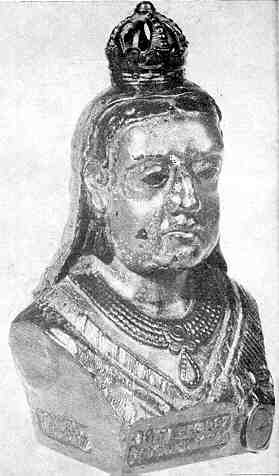A Pleasant Visit and the Queen Victoria Bank
by F.H. Griffith - HOBBIES Magazine - November, 1974
 A thoroughly pleasant visit, an enjoyable dinner, a chance to see
a great collection of early American tin toys, a collection of mechanical banks and cast
iron toys, folk art, weather vanes, fine decorative pieces all displayed most attractively
in a unique highly imaginative specially designed type of building that almost defies
description. Sufficient to say everything about the structure is keyed to the display of
the collections and the pleasure of living with them.
A thoroughly pleasant visit, an enjoyable dinner, a chance to see
a great collection of early American tin toys, a collection of mechanical banks and cast
iron toys, folk art, weather vanes, fine decorative pieces all displayed most attractively
in a unique highly imaginative specially designed type of building that almost defies
description. Sufficient to say everything about the structure is keyed to the display of
the collections and the pleasure of living with them.
Barney Barenholtz and his late wife Edith shared an intense interest in their respective hobbies, one hobby overlapping into the other. Edith was a highly unusual lady of great talent, sharing her interests with many, and many will miss the irreplaceable woman that she was.
Princeton, N.J., would seem to be ideally situated to the life style of the Barenholtz. Their home, gardens, attached housing for the collection all seem to fit in nicely with the surroundings. There is no doubt about it Barney has some fine pieces in the early tin toys, a very nice collection of cast iron toys, and in his collection of mechanical banks, mostly from the late Ed Richards’ collection, is the rare Queen Victoria Bust Bank. To the best of the writer’s knowledge, this is still the only example of the Queen Victoria known to exist in a private collection. So the opportunity was there on the occasion of the writer’s visit with Barney to examine the bank thoroughly and this he did. At long last now, and long overdue with no particular fault of anyone — we are able to pass along information on the Queen Victoria Bank.
To get this by the boards we have no choice at this time but to classify the bank as No. 231 in the numerical classification, although it naturally belongs considerably further up in the listing. This is not important — the important thing is to have the bank properly covered in article form as it is herewith.
The Queen Victoria Bank is a commemorative or celebration type item of great interest. We have so far not been able to pin it down to any one of the English manufacturers. The writer leans toward Harper, although he has no proof one way or the other. In any case, it is one of the really well cast English bust type banks and rather sizeable being 8¾ inches in height to top of crown. The date of the bank is well established by the bank itself since it was made for the Jubilee of 1887, celebrating 50 years of rule by Queen Victoria.
Following are the inscriptions in raised letters that appear on the bank — Lower front of bust "Jubilee 1887 God Save The Queen" — Lower right side of bust — "PATENT No 14197" — Back of bust "Born May 24th 1819 Crowned June 20th 1837 Married Feby 10th 1840." Certainly unusually great identification to have on a mechanical bank.
The coloring of the bank is rather dulled and it looks as though it may have been completely varnished or shellacked years ago leaving an overall dark color to the bank. In any case, the face is flesh color with red lips, the flowing hair cover or snood is tan, and her hair is black. Earrings, crown, and necklace are a japanned color, her dress top is brown with a red bow on the dress front left side. A perforated base plate with round holes is finished in a japanned color.
To operate the bank a coin is dropped into the provided slot located in the top of the crown, the weight of the coin causes the eyes to move up and down. The eyes are counter balanced and the coin hits an extension piece causing them to move for a period of time. In a fashion, the counter balanced action could be compared to the lower jaw of the whale on the Jonah & Whale Bank. Accumulated coins are removed from the bank by removing the perforated base plate.
In thinking through on the rarity and scarcity of the Queen Victoria Bust, it is no doubt due to the fact that it was a one occasion item for the year 1887, and unlike most other mechanicals, not made over a period of time or years. So production would have been limited even though a fair quantity may have been made.
